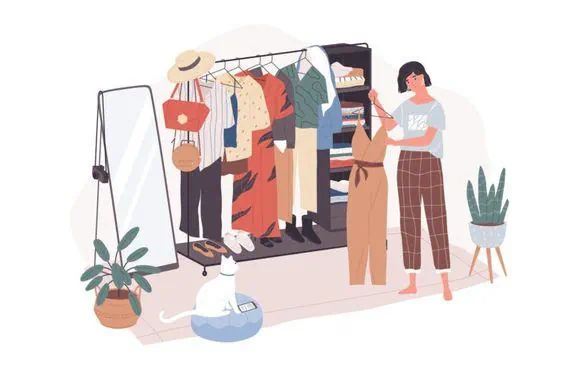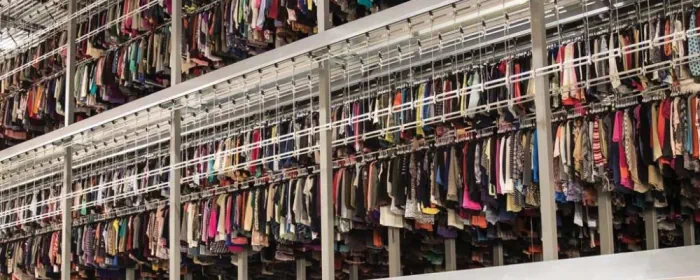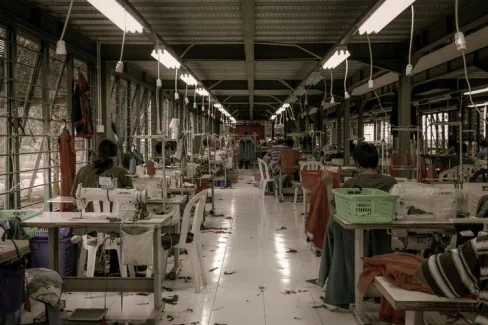
Environmental impact of our wardrobes

Table of Contents
Environmental impact of our wardrobes
Introduction
It is an old basic stereotype that only women are excited about clothes and in today’s society it is not the case anymore. Nowadays we can see men standing in lines in fashion stores, and they often need advice on how to dress. So the good news is you could find a bunch of not only fashion queens, but fashion kings also, giving tips on the Internet. Since the trend on social media doesn’t tolerate the same outfit twice, one might be forced to ask questions like “Do timeless clothing still exist?” and “Are our wardrobes overwhelmed with single-use pieces and how can we avoid it?”.

The girl picking an outfit (Pinterest)
Fashion industry nowadays
Observing a toddler for a few years we usually think to ourselves: “Wow, (s)he’s growing so fast”. The same manner we can notice how fast an industry can evolve especially when we, as a society, invest in its rapid development. Yes, we should be “proud” of the results. The dynamic changes in the fashion industry in the last two decades are outrageous. Ages before that, shopping was on our annual or seasonal to-do list or simply when we outgrew clothes, but it has become at least a weekly event. Such habits highlight the emergence of a concept of ’throwaway’ or fast fashion. “Fast fashion” is a key term and it describes a business model that achieves high profit by using cheap materials and labor to churn out low-priced, trendy, and easy dated collections as often as possible.

Chains of famous brands, such as Zara, H&M, GAP, and Forever21, implement catwalk ideas to their design and production, making it more affordable to dress up as your favorite celebrity. With each one of about 52 micro-seasons consumers are pushed into buying the latest pieces in the name of trend. If we would redirect focus from having a separate apartment only for clothes to the two biggest problems that this business model causes – Nature would be grateful. The problems that I just mentioned are “encouraging over-consumption and generating excessive waste”.
Environmental hazards during production
Water
I’ll be straightforward with you – I adore colorful clothes, and my favorite color is lilac. Doesn’t it look innocent? Well, don’t fall for it because dyes in garment factories are definitely not that harmless as they look, even if it’s pale violet. Although Nature has provided countless nuances, with the production levels continuing to rise, industry has found a solution in varied chemical compounds. It’s true - chemical dyes do bond better with the fabric, providing and retaining vivid color through time, but the cost that planet’s water flows pay is high.
More than 200 tonnes of water is used per one tonne of fabric in the textile industry. The massive use of water – to clean equipment, as cooling fluid, to rinse dyes and products - is a key element of pollution. Due to expensive wastewater treatments, leading companies choose to ignore regulations and to return this water to Nature as toxic waste. Water streams coming out of the factory contain micro-fibers, residual dyes and hazardous chemicals. The top pollutants are chromium, lead, and cadmium, since harmful and potentially lethal compound substances such as potassium dichromate, iron sulfate, chlorine compounds, arsenic, mercury, and many more are regularly used to achieve vibrant shades.
These kinds of chemicals do not break down as they are outpoured into the rivers. They flow around, going through cities, land fields, and canyons, straight to the seas and oceans causing dangerous scenarios. Documentary RiverBlue presents disturbing data in a brilliant way and shows how water that communities rely upon can easily become toxic to drink, an irritant when it comes in contact with our skin, and incapable of supporting almost any animal life.

Dye entering a river source: RiverBlue
An irresponsible way of treating a treasure such as water causes problems not only to nature but to the people all around the globe, especially ones who live in these polluted areas. Chromium has been shown to be carcinogenic, while lead causes neurological damage and cardiovascular diseases both in children and adults. This is the same water that is used to irrigate fertile lands that might end up not that fertile anymore. Scary, huh?
Gases
Wherever the industry is – there are harmful gases. According to figures from the United Nations Environment Programme (UNEP), the fashion industry accounts for 10% of global carbon emissions. For the record, the production of a single pair of jeans emits about 34 kg of CO2, which is equivalent to the emission from a 111 km car drive. So, how far could you drive according to how many pairs of jeans you have? Damn, I could have visited my crush, and he’s two countries away. Sadder than not getting a kiss, is that at this pace greenhouse gas emission caused by the fashion industry will surge more than 50 % in 10 years.
Fashion and oil
Speaking of denim jeans, they should be made of 100 % cotton. During the holidays it’s hard to stay fit, so we choose stretchy jeans, jean leggings, and jeggings, hoping we could fit into it for more than a few weeks. That’s when we open the closet door for synthetic fibers. With each collection that some brands release, petrol-based substances find their way into our clothes: elastane, polyester, nylon, acrylic. All of these are forms of plastic and you may wonder why would anyone want to make even underwear out of plastic. Well, synthetic plastic fibers are cheap and multipurpose, providing stretch and breathability in athleisure, and warmth in winter clothes.

A 2016 study by researchers at the University of California at Santa Barbara found that a synthetic fleece jacket releases approximately 1.7 grams of microplastic fibers with each wash. The journey of these tiny bombs is familiar - straight to the oceans and food chain.
Ethical hazards
“Fast fashion isn’t free. Someone, somewhere is paying”, said Lucy Siegle, British journalist and author of a documentary “The True Cost”.
Far from the eyes of the consumerist world, people are dying while making products. This fact stirred up the public on April 24th, 2013 when the Rana Plaza clothing manufacturing complex in Bangladesh collapsed, killing 1,134 workers and injured over 2,500, mostly women and girls.

People in garment industry in Indonesia, photo: Rio Lecatompessy
“At least, they have a job” is a gruesome phrase used by business owners to justify their negligence. But exploiting the vulnerability of poor people and children who have no choice is unforgivable. Inhumane working conditions, no healthcare, wages lower than the price of sandals and jeopardy daily are not worth it for someone else on the other side of the world to have a fancy look.
Don’t let your moral lines get blurred with the first red SALE label.
From the store to the landfill
Getting that prom dress years ago now seems like a bad choice. First, it turned out not to be my style anymore and I could not wear it to any other event and second, it increased the pile of unwanted clothes.
The world consumes 80 million new pieces of clothing every year. An average consumer in developed countries throws away around 31 kg of its textile each year, which is mostly deposited to landfills.

Walking through the piles of clothing waste, artist: Gabriella Street
Globally just 12% of the material used for clothing ends up being recycled. Labels, sewing threads, zips, buttons, materials blended with elastane make recycling difficult or impossible. Waste reduction is a helpful option in solving this problem.
How to turn your closet into a sustainable one
Without consumers making a change in their own habits, the fast fashion industry will never be pushed to change their business model. Hopefully, implementing simple steps by each one of us may have a great impact on Earth’s and society’s health. Here are few tips:
-
Buy less. And buy with longevity in the mind. Impulsive spending tends to be a modern disorder, and clothes nowadays are cheaper than ever so you usually don’t think twice about buying it. That’s the key – think twice. You probably don’t need everything that your favourite influencer has. I bet you could make a breathless outfit with simple pieces and effective jewelry you already have.
-
Try to shop (organic) natural fabrics. Trust me, your skin will be grateful. Cotton, hemp, and silk are pleasant and practical. These materials can be treated with little or no pesticides at all which makes them soil-friendly. Also, natural fibers are biodegradable and renewable. Ain’t that enough to forget about polyester forever? It’s not that hard to read a label.
-
Support local and ethical brands. Know your clothes – how and who’s making it. If you’re not sure, feel free to ask your favorite local brand where they get their materials from. Buying local cuts the carbon footprint, too.
-
Second hand and exchange. Secondhand and vintage stores always surprise me! Unique pieces are a real refreshment. But this one can be tricky so check tip #1 - do you need it or it’s just cheap? Your friend might have something similar that (s)he’ll not wear anymore, so you guys could exchange and find another purpose to the previously unwanted piece.
-
Organize your wardrobe. Take a day off, put your favorite music on, get a huge mirror and let your creative mind do the rest. Make new combinations if you don’t like simple style. Pack what you don’t need anymore and give it to your cousin, donate it or sell it at least. But never throw it into the bin!

The girls holding banners to raise awareness about caring for own textile illustration: Elin Svensson
Conclusion
Turning consumers into activists can raise the slow fashion for a few steps. It’s encouraging to know that you can contribute to environmental well-being by going for stylish quality and not trendy quantity. Caring for the planet never goes out of trend. Shop smart!